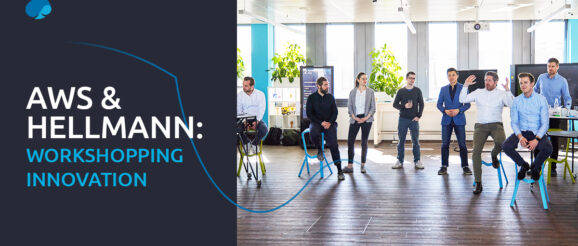Workshopping innovation with Hellmann

Workshopping innovation with Hellmann

Here’s how Hellmann Worldwide Logistics is creating an improved customer experience in collaboration with Capgemini’s Applied Innovation Exchange.
The pandemic and economic tensions around the world have been taxing, especially on businesses relying on the import and export of goods across international borders. This has thrown up a number of challenges for the logistics industry. On a mission to create a better customer experience and even smoother operations, Hellmann Worldwide Logistics joined forces with Capgemini’s Invent and Applied Innovation Exchange (AIE) teams in Munich and Amazon Web Services (AWS).
Creating an agile customer experience
Congested ports, limited capacities, enormous production backlogs: the pandemic, ongoing political tensions, and growing economic uncertainty around the world haven’t been easy on anyone – and the global logistics industry has been caught in the middle.
Companies have faced an array of production and shipping delays, all too often with little to no visibility of their shipment’s progress and limited flexibility. For Hellmann Worldwide Logistics, creating a more transparent customer experience was the incentive for partnering with Capgemini Invent, AIE Munich, and AWS for a three-day Rapid Innovation Discover workshop.
Innovation in progress
As we started our engagement with Hellman, the first challenge was to identify the main pain points in the current customer experience and write the problem statement.
Ahead of day one, our team from Capgemini Invent did a deep dive into the logistics industry as well as the problem context.
“For innovation to thrive successfully, it’s crucial to identify and define a clear problem statement.”
Dominik Schindler, Senior Manager Corporate Experience, Capgemini Invent Germany
This formed the basis for the workshop and included diving into relevant startup and technology trends in the logistics industry. On top of that, Capgemini Invent surveyed relevant members of the Hellmann team to gain more insight into the workings and vision for their operations.
Our research revealed a clear need for more transparency, autonomy, and flexibility for Hellmann’s clients to help them organize their internal organizations more reliably and not feel left in the dark. We needed to find a way to help them take back control and allow them to take matters into their own hands.
Working with the problem
After presenting our research findings and creative methodologies, including one from our innovation partner AWS, day one of the workshop kicked off with an ideation session to brainstorm potential solutions to Hellmann’s problem statement. Depending on the problem we’re looking to address, we can leverage different creative techniques. In this case, we decided to start with something called the crazy eight method.
This means every workshop participant is tasked to come up with eight potential ideas. At this stage, it’s not so much about the quality of the idea but more about the quantity. It’s about not giving it too much thought and just firing away to see what sticks. In this session, we ended up with 121 different ideas between four groups.
Then it was time to develop the most promising ideas. Here, our team at the AIE Munich decided to go with an exercise called the idea tower, where each participant chooses to work on one idea from the pool. They then continue to build it out based on relevant factors from the problem statement. Each person has three minutes to develop the idea further, then they hand their notes on to the next person, who continues to build on the idea. This helped narrow the field down to 16 potential solutions.
Following a democratic process, the groups agreed on three key ideas that addressed Hellmann’s problem best, but only one came out on top. This idea centered around a new customer experience that allows Hellmann’s customers to actively manage their shipments.
From idea to prototype
On day two of the workshop, the teams followed AWS’s “Working Backwards” method to take the idea from concept to tangible prototype. Under this approach, teams are divided into smaller groups to draft a press release and FAQs, and to prototype visuals for the chosen idea.
Day three was spent iterating on the three Working Backwards artifacts as well as creating a business model canvas, an initial solution architecture, and a first business case. These, in addition to the prototype, were tested with several Hellmann clients to get feedback in real time.
As the dynamics across the globe continue to change and evolve, finding new ways to grow your enterprise and adapt to customer needs is vital for long-term survival. Keeping on top of innovation trends in your industry and harnessing the power of an innovation ecosystem, like the Capgemini AIE, can help secure business success.
Visit Capgemini’s AIE to learn more.

Innovation Consultant, Applied Business Exchange, Startup Catalyst, Germany
She has a background in innovation management and focuses on driving innovation topics forward together with clients from various industries.
The aspect of sustainability plays a particularly important role for her, because sustainability and innovation must go hand in hand.
The post Workshopping innovation with Hellmann appeared first on Capgemini.
